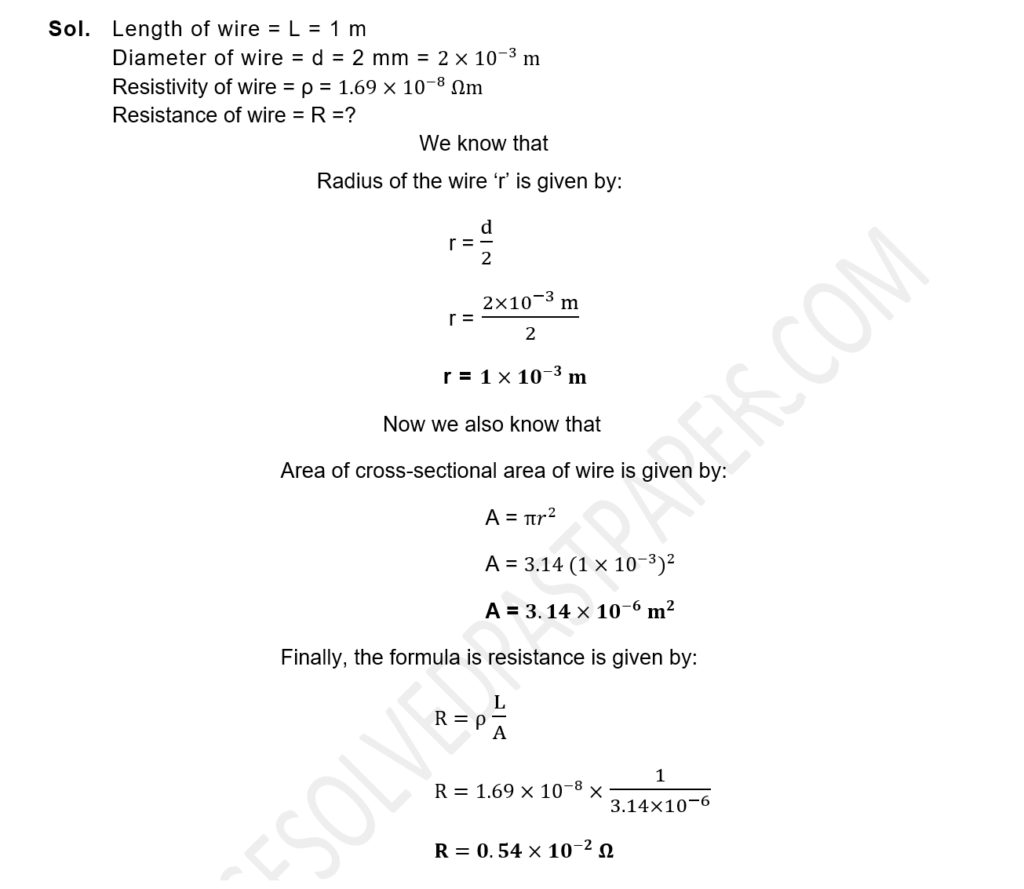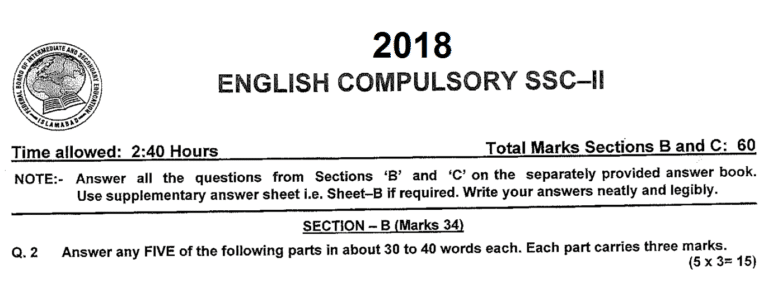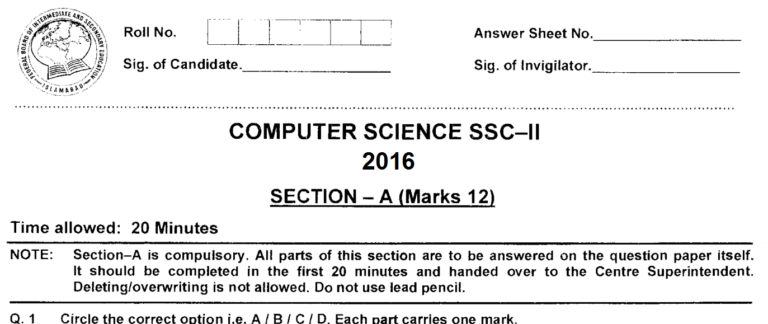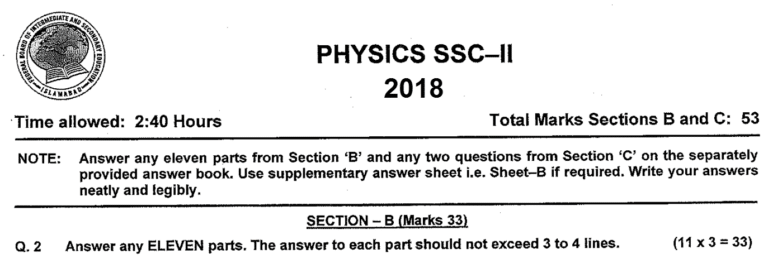Class 10 Physics 2018 Overseas Solved Past Paper Federal Board
Federal Board Class 10 Physics 2018 Overseas Solved Past Paper Federal Board. Paper is solved for helping students. For more solved papers visit Class 10 Solved Past Papers page.
Class 10 Physics 2018 Overseas Paper
Section A
Q1. MCQs Click HERE for MCQs Practice Tests.
Click HERE for MCQs Practice Tests.
Class 10 Physics 2018 Overseas
Section B
Q2.
(i) Prove that v=f λ

(ii) Differentiate loudness and intensity of sound.
Ans.
| Loudness | Intensity |
| The sensation produced by sound on our ears is called loudness of sound. | The sound energy flowing through the unit area held per to the direction of sound in unit time is called the intensity of sound. |
| It has no unit. | Its SI unit is Wm-2. |
| It is not a physical quantity. | It is a physical quantity. |
| It depends upon the condition of the ear. | It does not depend upon the condition of the ear. |
(iii) Why the voice of women is more shrill than that of men?
Ans. Shrill and grave sounds can be distinguished by their pitch and frequency. The higher the frequency, the higher will be the pitch, and the shrill sound is produced. Women’s and children’s voices have high pitch and frequency. Therefore, they are shriller than the voices of men.
(iv) Define the following terms of lens:
a. Principal axis
b. Optical centre
c. Power of lens
Ans. Principal Axis
A straight line passing through the optical center and the principal focus of a lens is called its principal axis.
Optical Centre
A point on the principal axis at the center of a lens is called an optical center.
Power of Lens
The reciprocal of focal length expressed in meters is called the power of lens. It is given by P = 1/ f.
The unit of power of the lens is “diopter” denoted by “D”. The power of a lens is said to be one diopter if its focal length is one meter. The power of the convex lens is positive whereas the power of the concave lens is negative.
(v) Why is the driver’s side mirror in many cars convex rather than plane or concave?
Excluded from Syllabus for Annual Exams 2021
(vi) Why do we use a refracting telescope with a large objective lens of a large focal length?
Excluded from Syllabus for Annual Exams 2021
(vii) What is the difference between variable and fixed capacitor?
Excluded from Syllabus for Annual Exams 2021
(viii) Describe briefly electrostatic air cleaner.
Excluded from Syllabus for Annual Exams 2021
(ix) Differentiate between electromotive force and potential difference.
Ans. Potential Difference
The potential difference across the two ends of a conductor causes the dissipation of electrical energy per unit charge into other forms of energy as charges flow through the circuit. Its unit is volt represented by V.
It is given by V = VA – VB
Where VA = Potential at point A
VB = Potential at point B
Electromotive Force (e.m.f)
It is the energy supplied by a battery to a unit positive charge when it flows through the closed circuit. Or The energy converted from non-electrical forms to electrical form when one coulomb of positive charge passes through the battery. Thus,

(x) Why ammeter is always connected in series with circuit?
Excluded from Syllabus for Annual Exams 2021
(xi) Does a fuse in a circuit control the potential difference or the current?
Excluded from Syllabus for Annual Exams 2021
(xii) State Faraday’s law of electromagnetic induction.
Ans. Faraday’s law of electromagnetic induction
This law states that “The value of induced e.m.f in a circuit is directly proportional to the rate of change of number of magnetic lines of force through it”.
(xiii) Can a transformer operate on direct current?
Ans. No, a transformer cannot be operated on direct current because a transformer works on the principle of mutual induction that requires changing magnetic field. Since direct current does not provide changing magnetic field therefore transformer does not work on direct current.
(xiv) What is a supercomputer?
Excluded from Syllabus for Annual Exams 2021
(xv) Make a truth table of:
a. AND gate
b. OR gate
Section C
Attempt any Two Questions
Q3. a. Define Nuclear fission reaction and fission chain reaction. Differentiate between controlled and uncontrolled fission chain reaction. (1+2+3)
Ans. Nuclear Fission Reaction:
A process in which a heavy nucleus breaks into two nearly equal parts with the release of large energy is called nuclear fission.
Nuclear fission takes place when a heavy nucleus, such as U-235, splits, or fissions, into two smaller nuclei by absorbing a slow-moving (low-energy) neutron.
Reaction:

Diagram:

Where is an intermediate state that lasts only for a fraction of a second before splitting into nuclei X and Y, called fission fragments.
Fission Chain Reaction:
When a neutron reacts with a uranium nucleus, two or three neutrons are released. Every one of these neutrons reacts with the next nuclei producing two or three more neutrons and hence the number of available neutrons and the fission goes on increasing. Such a reaction is called a chain reaction.

Controlled Fission Chain Reaction:
When extra neutrons liberated in fission reactions are absorbed using some material to slow down the chain reaction, the reaction is called a controlled fission chain reaction. This type of reaction is self-sustained and used in nuclear reactors. A nuclear reactor provides energy for useful purposes.
Uncontrolled Fission Chain Reaction:
Calculations show that if the chain reaction is not controlled, it will proceed too rapidly and possibly results in the sudden release of an enormous amount of energy (an explosion). This type of reaction is used in atomic bombs.
Q3. b. If the length of copper wire is 1 m and its diameter is 2mm then find the resistance of this copper wire. (Resistivity of wire is 1.69 x10-8 Ωm). (04)

Q4. a. Define C.R.O. Draw the labeled diagram of C.R.O. Explain the working of different parts of C.R.O. (1+2+3)
Excluded from Syllabus for Annual Exams 2021
Q4. b. Calculate the intensity level of the faintest audible sound in decibel. (04)
Q5. a. Explain the following properties of the wave with reference to the ripple tank experiment: (2+2+2)
(i) Reflection (ii) Refraction (iii) Diffraction
Excluded from Syllabus for Annual Exams 2021
Q5. b. A sound wave has a frequency of 2 kHz and a wavelength of 35cm. How long will it take to travel 1.5 km?
Sol. Frequency of sound wave = f = 2 kHz = 2000 Hz
Wavelength = λ = 35 cm = 0.35 m
Distance = S = 1.5 km = 1500 m
Time = t =?
First using wave equation to find velocity
v = f λ
v = (2000) (0.35)
v = 700 ms-1
Now we know that
S = v t
t = S / v
t = 1500 / 700
t = 2.1 s





